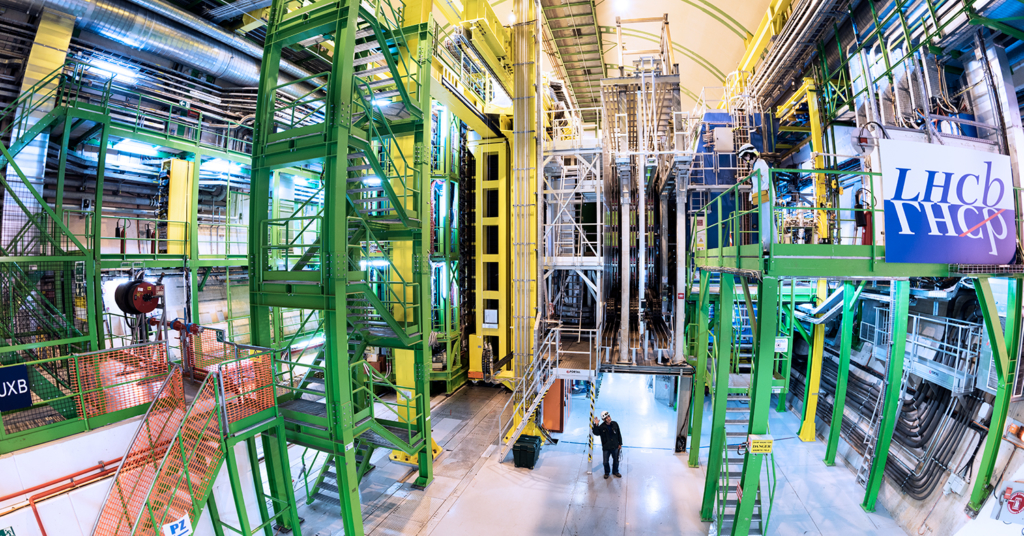A report from the LHCb experiment
The Cabibbo–Kobayashi–Maskawa (CKM) matrix element Vub describes the coupling between u and b quarks in the weak interaction, and is one of the fundamental parameters of the Standard Model (SM). Though it was first observed to be non-zero 30 years ago, its value is still debated. |Vub| determines the length of the least well-known side of the corresponding unitarity triangle, and is therefore a key ingredient for testing the consistency of the SM in the flavour sector. LHCb has recently published a new result on |Vub| using the first ever measurement of the Bs0 → K–μ+νμ decay.

|Vub| and |Vcb| are the focus of a longstanding puzzle. When comparing the world-average values derived from inclusive and exclusive B-meson decays, respectively, the inclusive and exclusive measurements disagree by more than three standard deviations, for measurements of both |Vub| and |Vcb|. Traditionally, the exclusive |Vub| determination requires the reconstruction of the semileptonic b → u decay B0 → π–μ+νμ. LHCb also has access to Bs0 meson and b-baryon decays, but the missing neutrino makes it difficult to isolate the signal from the copious background. Defying expectations, however, in 2015 LHCb managed to observe the Λb0 → pμ–νμ decay, and used the normalisation channel Λb0 → Λ+cμ–νμ to determine |Vub|/ |Vcb|. The main difficulty in this type of analysis resides in the fact that only two charged particles are reconstructed in decays such as Bs0 → K–μ+νμ and Λb0 → pμ–νμ. A huge background arising from other sources dominates the selected data sample. Machine-learning algorithms are therefore used to isolate the signal from the various background categories consisting of decays with additional charged and/or neutral particles in the final state. The remaining irreducible background is modelled by using both simulation and control samples extracted from data.
This is the first experimental test of the form-factor calculations
First observation
In a recent paper, the LHCb collaboration presented the first observation of the decay Bs0 → K–μ+νμ. The decay Bs0 → Ds– μ+νμ is used as a normalisation channel to minimise experimental systematic uncertainties. The study was performed in two regions of the squared invariant mass (or momentum transfer) q2 of the muon and the neutrino below and above 7 GeV2. The observed total yield was about 13,000 events, corresponding to a branching fraction of (1.06 ± 0.10) × 10–4, of which about one third stemmed from the low q2 range (figure 1).

The extraction of the ratio |Vub|/|Vcb| requires external knowledge of the form factors describing the strong Bs0 → K– and Bs0 → Ds– transitions, to account for the interactions of the quarks bound in mesons. These vary with the momentum transfer and are calculated using non-perturbative techniques, such as lattice QCD (LQCD) and light-cone sum rules (LCSR). As LQCD and LCSR calculations are more accurate at high and low q2, respectively, they are used in the corresponding q2 regions. The obtained value of |Vub|/|Vcb| = 0.095 ± 0.008 in the high q2 interval shows agreement with the world average of exclusive measurements, and with the LHCb result using Λb0 → pμ–νμ decays, while in the low q2 region, |Vub|/|Vcb| = 0.061 ± 0.004 is significantly lower (figure 2). This is the first experimental test of the form-factor calculations, and new results are expected in the near future. These will help settle the exclusive versus inclusive debate surrounding the values of |Vub| and |Vcb|, and provide further constraints on the unitarity triangle.
Further reading
LHCb Collaboration 2020 arXiv:2012.05143









